battery location FORD SIERRA 1992 2.G Engine Electrical Systems Workshop Manual
[x] Cancel search | Manufacturer: FORD, Model Year: 1992, Model line: SIERRA, Model: FORD SIERRA 1992 2.GPages: 24, PDF Size: 0.93 MB
Page 5 of 24
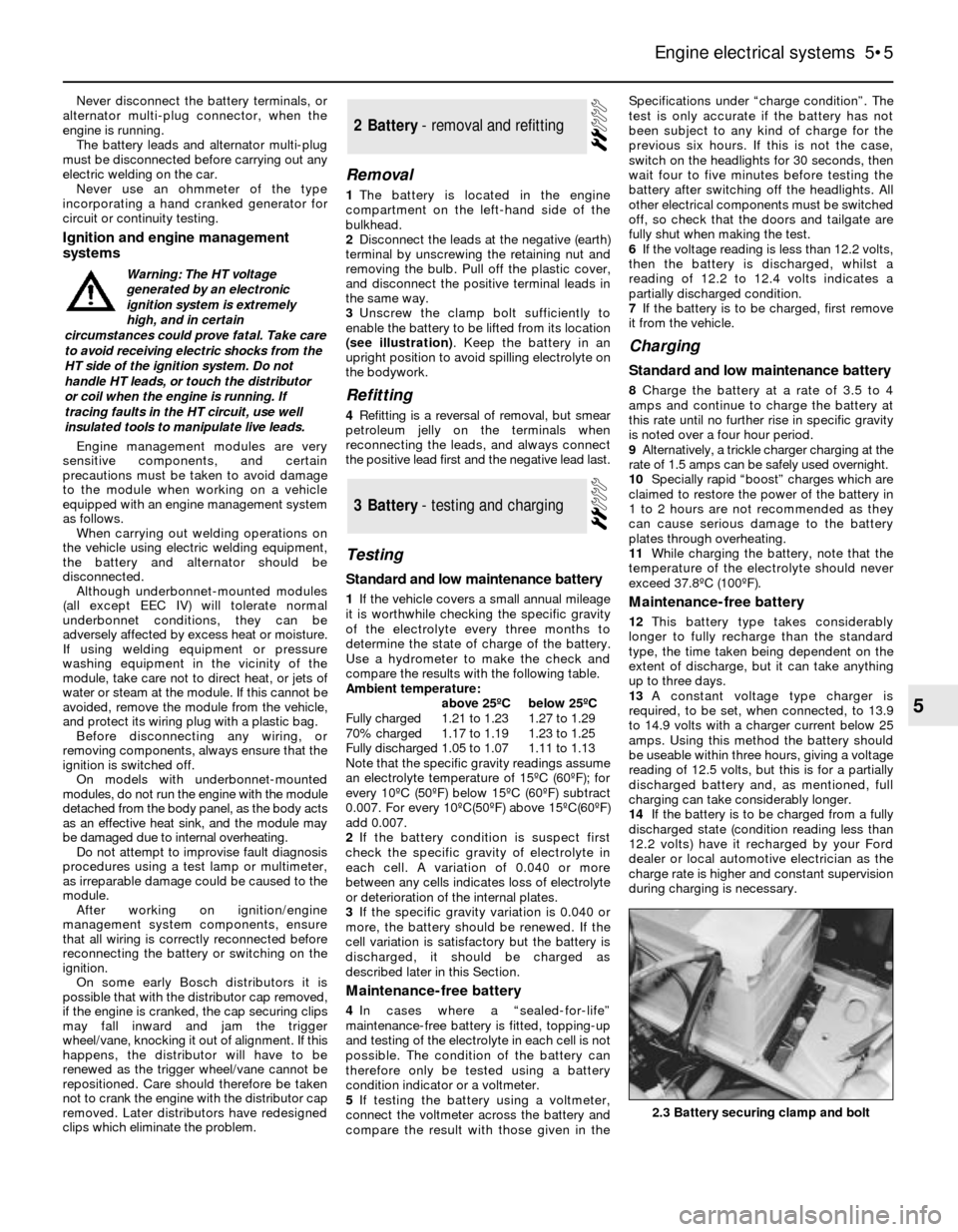
Never disconnect the battery terminals, or
alternator multi-plug connector, when the
engine is running.
The battery leads and alternator multi-plug
must be disconnected before carrying out any
electric welding on the car.
Never use an ohmmeter of the type
incorporating a hand cranked generator for
circuit or continuity testing.
Ignition and engine management
systems
Engine management modules are very
sensitive components, and certain
precautions must be taken to avoid damage
to the module when working on a vehicle
equipped with an engine management system
as follows.
When carrying out welding operations on
the vehicle using electric welding equipment,
the battery and alternator should be
disconnected.
Although underbonnet-mounted modules
(all except EEC IV) will tolerate normal
underbonnet conditions, they can be
adversely affected by excess heat or moisture.
If using welding equipment or pressure
washing equipment in the vicinity of the
module, take care not to direct heat, or jets of
water or steam at the module. If this cannot be
avoided, remove the module from the vehicle,
and protect its wiring plug with a plastic bag.
Before disconnecting any wiring, or
removing components, always ensure that the
ignition is switched off.
On models with underbonnet-mounted
modules, do not run the engine with the module
detached from the body panel, as the body acts
as an effective heat sink, and the module may
be damaged due to internal overheating.
Do not attempt to improvise fault diagnosis
procedures using a test lamp or multimeter,
as irreparable damage could be caused to the
module.
After working on ignition/engine
management system components, ensure
that all wiring is correctly reconnected before
reconnecting the battery or switching on the
ignition.
On some early Bosch distributors it is
possible that with the distributor cap removed,
if the engine is cranked, the cap securing clips
may fall inward and jam the trigger
wheel/vane, knocking it out of alignment. If this
happens, the distributor will have to be
renewed as the trigger wheel/vane cannot be
repositioned. Care should therefore be taken
not to crank the engine with the distributor cap
removed. Later distributors have redesigned
clips which eliminate the problem.
Removal
1The battery is located in the engine
compartment on the left-hand side of the
bulkhead.
2Disconnect the leads at the negative (earth)
terminal by unscrewing the retaining nut and
removing the bulb. Pull off the plastic cover,
and disconnect the positive terminal leads in
the same way.
3Unscrew the clamp bolt sufficiently to
enable the battery to be lifted from its location
(see illustration). Keep the battery in an
upright position to avoid spilling electrolyte on
the bodywork.
Refitting
4Refitting is a reversal of removal, but smear
petroleum jelly on the terminals when
reconnecting the leads, and always connect
the positive lead first and the negative lead last.
Testing
Standard and low maintenance battery
1If the vehicle covers a small annual mileage
it is worthwhile checking the specific gravity
of the electrolyte every three months to
determine the state of charge of the battery.
Use a hydrometer to make the check and
compare the results with the following table.
Ambient temperature:
above 25ºCbelow 25ºC
Fully charged1.21 to 1.231.27 to 1.29
70% charged1.17 to 1.191.23 to 1.25
Fully discharged1.05 to 1.071.11 to 1.13
Note that the specific gravity readings assume
an electrolyte temperature of 15ºC (60ºF); for
every 10ºC (50ºF) below 15ºC (60ºF) subtract
0.007. For every 10ºC(50ºF) above 15ºC(60ºF)
add 0.007.
2If the battery condition is suspect first
check the specific gravity of electrolyte in
each cell. A variation of 0.040 or more
between any cells indicates loss of electrolyte
or deterioration of the internal plates.
3If the specific gravity variation is 0.040 or
more, the battery should be renewed. If the
cell variation is satisfactory but the battery is
discharged, it should be charged as
described later in this Section.
Maintenance-free battery
4In cases where a “sealed-for-life”
maintenance-free battery is fitted, topping-up
and testing of the electrolyte in each cell is not
possible. The condition of the battery can
therefore only be tested using a battery
condition indicator or a voltmeter.
5If testing the battery using a voltmeter,
connect the voltmeter across the battery and
compare the result with those given in theSpecifications under “charge condition”. The
test is only accurate if the battery has not
been subject to any kind of charge for the
previous six hours. If this is not the case,
switch on the headlights for 30 seconds, then
wait four to five minutes before testing the
battery after switching off the headlights. All
other electrical components must be switched
off, so check that the doors and tailgate are
fully shut when making the test.
6If the voltage reading is less than 12.2 volts,
then the battery is discharged, whilst a
reading of 12.2 to 12.4 volts indicates a
partially discharged condition.
7If the battery is to be charged, first remove
it from the vehicle.
Charging
Standard and low maintenance battery
8Charge the battery at a rate of 3.5 to 4
amps and continue to charge the battery at
this rate until no further rise in specific gravity
is noted over a four hour period.
9Alternatively, a trickle charger charging at the
rate of 1.5 amps can be safely used overnight.
10Specially rapid “boost” charges which are
claimed to restore the power of the battery in
1 to 2 hours are not recommended as they
can cause serious damage to the battery
plates through overheating.
11While charging the battery, note that the
temperature of the electrolyte should never
exceed 37.8ºC (100ºF).
Maintenance-free battery
12This battery type takes considerably
longer to fully recharge than the standard
type, the time taken being dependent on the
extent of discharge, but it can take anything
up to three days.
13A constant voltage type charger is
required, to be set, when connected, to 13.9
to 14.9 volts with a charger current below 25
amps. Using this method the battery should
be useable within three hours, giving a voltage
reading of 12.5 volts, but this is for a partially
discharged battery and, as mentioned, full
charging can take considerably longer.
14If the battery is to be charged from a fully
discharged state (condition reading less than
12.2 volts) have it recharged by your Ford
dealer or local automotive electrician as the
charge rate is higher and constant supervision
during charging is necessary.
3Battery - testing and charging
2Battery - removal and refitting
Engine electrical systems 5•5
5
2.3 Battery securing clamp and bolt
Warning: The HT voltage
generated by an electronic
ignition system is extremely
high, and in certain
circumstances could prove fatal. Take care
to avoid receiving electric shocks from the
HT side of the ignition system. Do not
handle HT leads, or touch the distributor
or coil when the engine is running. If
tracing faults in the HT circuit, use well
insulated tools to manipulate live leads.
Page 6 of 24

Removal
1Disconnect the battery leads.
2Disconnect the multi-plug, or disconnect
the wires from their terminals on the rear of
the alternator, noting their locations (as
applicable), then slacken the mounting and
adjustment bolts and tilt the alternator
towards the engine (see illustrations).
3Remove the drivebelt(s) from the alternator
pulley(s).
4Remove the mounting and adjustment nuts
and bolts, and withdraw the alternator from
the engine.
Refitting
5Refitting is a reversal of removal, noting the
following points.
6To avoid breakage of the alternator
mounting bracket lugs, it is important that the
following procedure is adhered to when
refitting the mounting bolts.
7Always refit the large flat washer (A) (see
illustration).
8Earlier models (before 1985) also have a
small washer (B) which must be fitted between
the sliding bush and the mounting bracket.
9Ensure that the bushes and bolts are
assembled as shown - except on 2.0 litre
DOHC models where a through-bolt is used,
then tension the drivebelt(s) and tighten the
mounting and adjustment bolts as shown in
the relevant illustration in Chapter 3.Refer to Chapter 1, Section 21.
Note: To carry out the complete test procedure
use only the following test equipment - a 0 to
20 volt moving coil voltmeter, a 0 to 100 amp
moving coil ammeter, and a rheostat rated at
30 amps.
1Check that the battery is at least 70%
charged by using a hydrometer.
2Check the drivebelt tension.
3Check the security of the battery leads,
alternator multi-plug, and interconnecting wire.
Cable continuity check
4Pull the multi-plug from the alternator and
switch on the ignition, being careful not to crank
the engine. Connect the voltmeter between a
good earth and each of the terminals in the
multi-plug in turn. If battery voltage is not
indicated, there is an open circuit in the wiring
which may be due to a blown ignition warning
light bulb if on the small terminal.
Alternator output check
5Connect the voltmeter, ammeter and
rheostat as shown (see illustration).Run the
engine at 3000 rpm and switch on the
headlamps, heater blower and, where fitted,
the heated rear window. Vary the resistanceto increase the current and check that the
alternator rated output is reached without the
voltage dropping below 13 volts.
Charging circuit positive side
check
6Connect the voltmeter as shown (see
illustration).Start the engine and switch on
the headlamps. Run the engine at 3000 rpm
and check that the indicated voltage drop
does not exceed 0.5 volt. A higher reading
indicates a high resistance such as a dirty
connection on the positive side of the
charging circuit.
Charging circuit negative side
check
7Connect the voltmeter as shown (see
illustration).Start the engine and switch on
the headlamps. Run the engine at 3000 rpm
and check that the indicated voltage drop
does not exceed 0.25 volt. A higher reading
indicates a high resistance such as a dirty
connection on the negative side of the
charging circuit.
Voltage regulator check
8Connect the voltmeter and ammeter as
shown(see illustration).Run the engine at
3000 rpm and when the ammeter records a
current of 3 to 5 amps check that the voltmeter
records 13.7 to 14.15 volts. If the result is
outside the limits the regulator is faulty.
6Alternator - testing
5Alternator drivebelt(s) - checking,
renewal and tensioning4Alternator - removal and
refitting
5•6Engine electrical systems
4.2a Disconnecting the multi-plug from a
Bosch alternator4.7 Alternator mounting bracket
arrangement
A Large flat washer
B Small flat washer (models up to 1985 only)
C Mounting bracket (engine)
D Mounting lugs (alternator)
6.7 Alternator negative check circuit6.6 Alternator positive check circuit6.5 Alternator output test circuit
4.2b Removing the insulating cap from the
main wiring terminal on a Lucas A127
alternator (CVH model)
Page 9 of 24
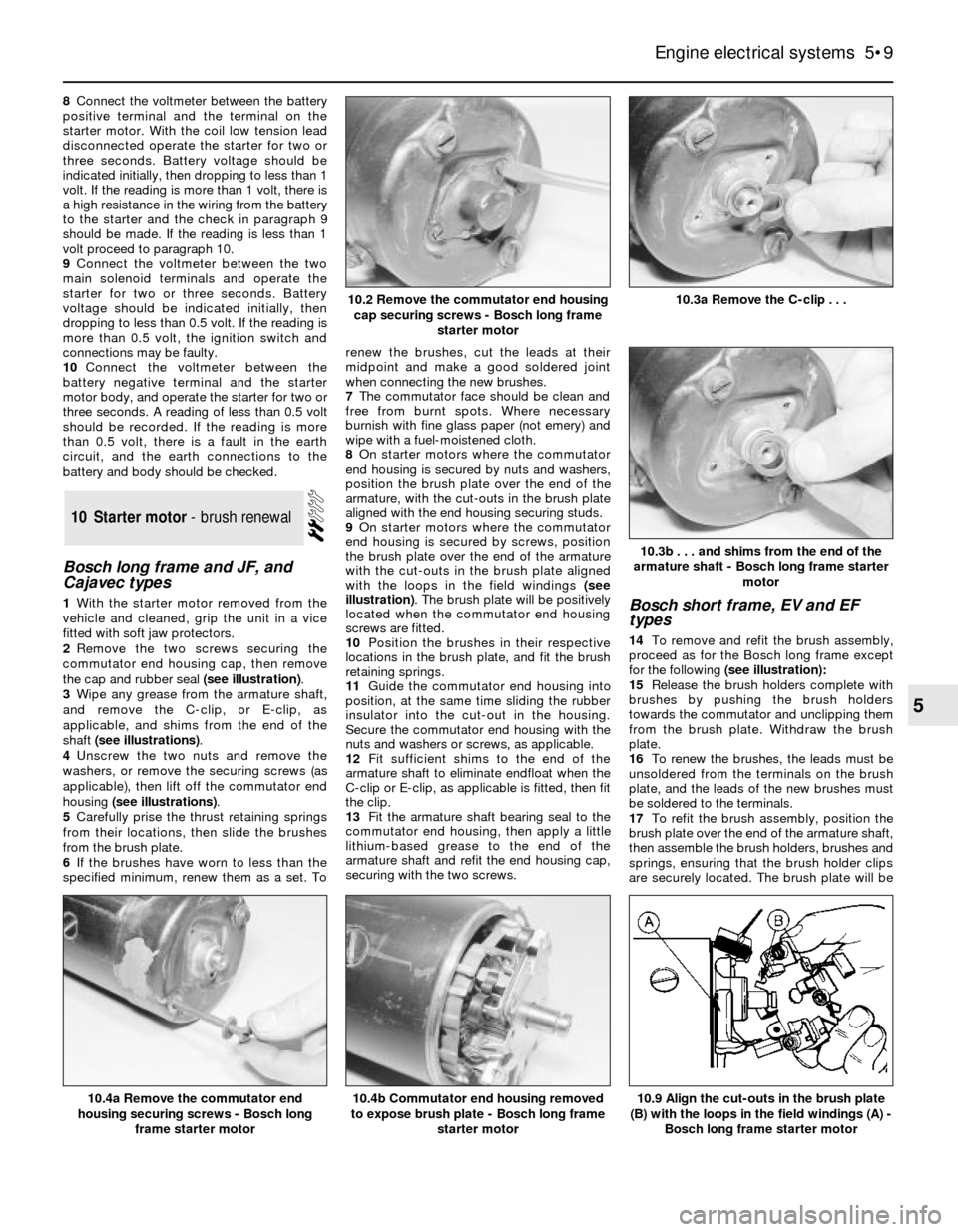
8Connect the voltmeter between the battery
positive terminal and the terminal on the
starter motor. With the coil low tension lead
disconnected operate the starter for two or
three seconds. Battery voltage should be
indicated initially, then dropping to less than 1
volt. If the reading is more than 1 volt, there is
a high resistance in the wiring from the battery
to the starter and the check in paragraph 9
should be made. If the reading is less than 1
volt proceed to paragraph 10.
9Connect the voltmeter between the two
main solenoid terminals and operate the
starter for two or three seconds. Battery
voltage should be indicated initially, then
dropping to less than 0.5 volt. If the reading is
more than 0.5 volt, the ignition switch and
connections may be faulty.
10Connect the voltmeter between the
battery negative terminal and the starter
motor body, and operate the starter for two or
three seconds. A reading of less than 0.5 volt
should be recorded. If the reading is more
than 0.5 volt, there is a fault in the earth
circuit, and the earth connections to the
battery and body should be checked.
Bosch long frame and JF, and
Cajavec types
1With the starter motor removed from the
vehicle and cleaned, grip the unit in a vice
fitted with soft jaw protectors.
2Remove the two screws securing the
commutator end housing cap, then remove
the cap and rubber seal (see illustration).
3Wipe any grease from the armature shaft,
and remove the C-clip, or E-clip, as
applicable, and shims from the end of the
shaft (see illustrations).
4Unscrew the two nuts and remove the
washers, or remove the securing screws (as
applicable), then lift off the commutator end
housing (see illustrations).
5Carefully prise the thrust retaining springs
from their locations, then slide the brushes
from the brush plate.
6If the brushes have worn to less than the
specified minimum, renew them as a set. Torenew the brushes, cut the leads at their
midpoint and make a good soldered joint
when connecting the new brushes.
7The commutator face should be clean and
free from burnt spots. Where necessary
burnish with fine glass paper (not emery) and
wipe with a fuel-moistened cloth.
8On starter motors where the commutator
end housing is secured by nuts and washers,
position the brush plate over the end of the
armature, with the cut-outs in the brush plate
aligned with the end housing securing studs.
9On starter motors where the commutator
end housing is secured by screws, position
the brush plate over the end of the armature
with the cut-outs in the brush plate aligned
with the loops in the field windings (see
illustration). The brush plate will be positively
located when the commutator end housing
screws are fitted.
10Position the brushes in their respective
locations in the brush plate, and fit the brush
retaining springs.
11Guide the commutator end housing into
position, at the same time sliding the rubber
insulator into the cut-out in the housing.
Secure the commutator end housing with the
nuts and washers or screws, as applicable.
12Fit sufficient shims to the end of the
armature shaft to eliminate endfloat when the
C-clip or E-clip, as applicable is fitted, then fit
the clip.
13Fit the armature shaft bearing seal to the
commutator end housing, then apply a little
lithium-based grease to the end of the
armature shaft and refit the end housing cap,
securing with the two screws.Bosch short frame, EV and EF
types
14To remove and refit the brush assembly,
proceed as for the Bosch long frame except
for the following(see illustration):
15Release the brush holders complete with
brushes by pushing the brush holders
towards the commutator and unclipping them
from the brush plate. Withdraw the brush
plate.
16To renew the brushes, the leads must be
unsoldered from the terminals on the brush
plate, and the leads of the new brushes must
be soldered to the terminals.
17To refit the brush assembly, position the
brush plate over the end of the armature shaft,
then assemble the brush holders, brushes and
springs, ensuring that the brush holder clips
are securely located. The brush plate will be
10Starter motor - brush renewal
Engine electrical systems 5•9
5
10.3b . . . and shims from the end of the
armature shaft - Bosch long frame starter
motor
10.9 Align the cut-outs in the brush plate
(B) with the loops in the field windings (A) -
Bosch long frame starter motor10.4b Commutator end housing removed
to expose brush plate - Bosch long frame
starter motor10.4a Remove the commutator end
housing securing screws - Bosch long
frame starter motor
10.3a Remove the C-clip . . .10.2 Remove the commutator end housing
cap securing screws - Bosch long frame
starter motor
Page 14 of 24
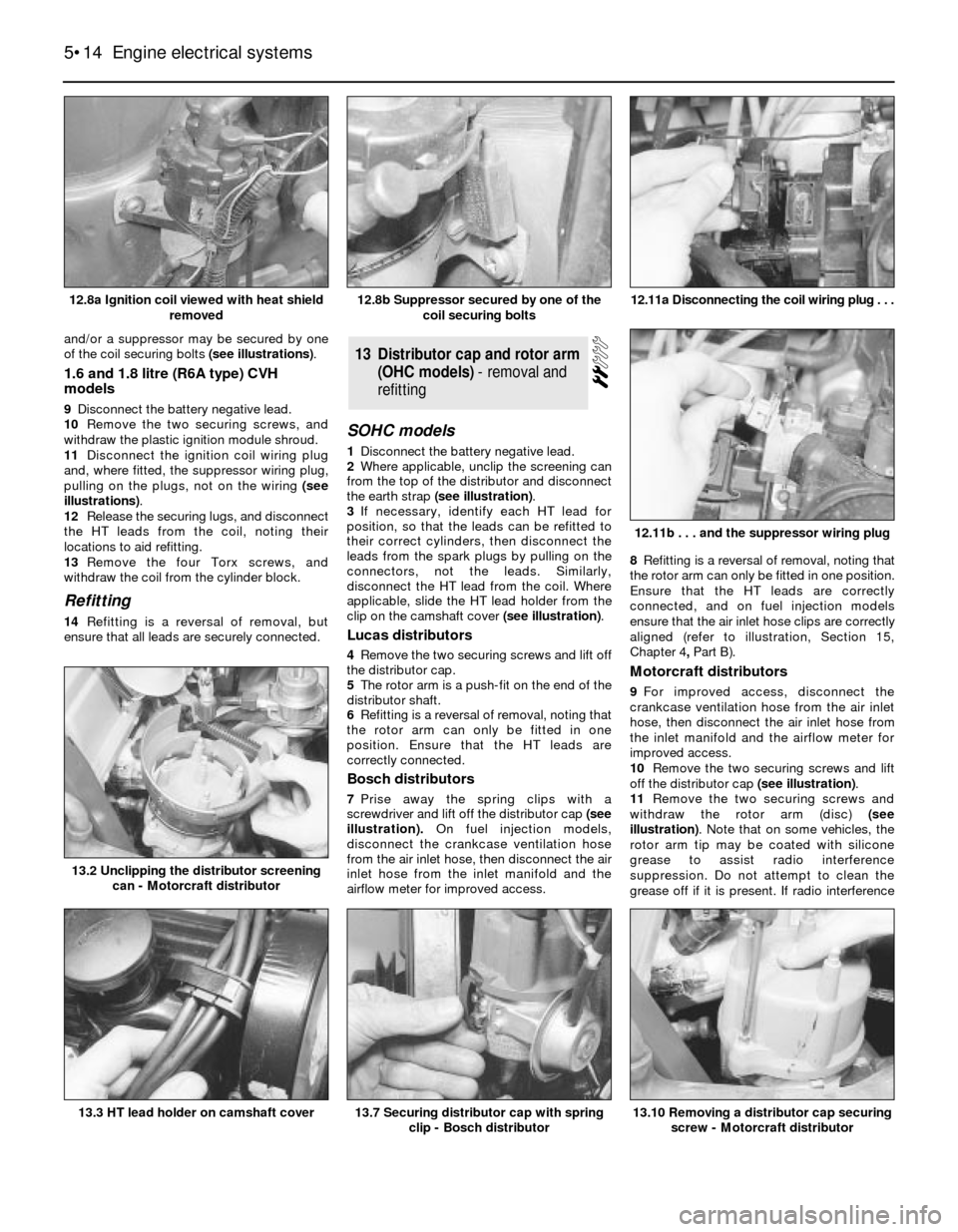
and/or a suppressor may be secured by one
of the coil securing bolts (see illustrations).
1.6 and 1.8 litre (R6A type) CVH
models
9Disconnect the battery negative lead.
10Remove the two securing screws, and
withdraw the plastic ignition module shroud.
11Disconnect the ignition coil wiring plug
and, where fitted, the suppressor wiring plug,
pulling on the plugs, not on the wiring (see
illustrations).
12Release the securing lugs, and disconnect
the HT leads from the coil, noting their
locations to aid refitting.
13Remove the four Torx screws, and
withdraw the coil from the cylinder block.
Refitting
14Refitting is a reversal of removal, but
ensure that all leads are securely connected.
SOHC models
1Disconnect the battery negative lead.
2Where applicable, unclip the screening can
from the top of the distributor and disconnect
the earth strap (see illustration).
3If necessary, identify each HT lead for
position, so that the leads can be refitted to
their correct cylinders, then disconnect the
leads from the spark plugs by pulling on the
connectors, not the leads. Similarly,
disconnect the HT lead from the coil. Where
applicable, slide the HT lead holder from the
clip on the camshaft cover (see illustration).
Lucas distributors
4Remove the two securing screws and lift off
the distributor cap.
5The rotor arm is a push-fit on the end of the
distributor shaft.
6Refitting is a reversal of removal, noting that
the rotor arm can only be fitted in one
position. Ensure that the HT leads are
correctly connected.
Bosch distributors
7Prise away the spring clips with a
screwdriver and lift off the distributor cap(see
illustration).On fuel injection models,
disconnect the crankcase ventilation hose
from the air inlet hose, then disconnect the air
inlet hose from the inlet manifold and the
airflow meter for improved access. 8Refitting is a reversal of removal, noting that
the rotor arm can only be fitted in one position.
Ensure that the HT leads are correctly
connected, and on fuel injection models
ensure that the air inlet hose clips are correctly
aligned (refer to illustration, Section 15,
Chapter 4, PartB).
Motorcraft distributors
9For improved access, disconnect the
crankcase ventilation hose from the air inlet
hose, then disconnect the air inlet hose from
the inlet manifold and the airflow meter for
improved access.
10Remove the two securing screws and lift
off the distributor cap (see illustration).
11Remove the two securing screws and
withdraw the rotor arm (disc) (see
illustration). Note that on some vehicles, the
rotor arm tip may be coated with silicone
grease to assist radio interference
suppression. Do not attempt to clean the
grease off if it is present. If radio interference
13Distributor cap and rotor arm
(OHC models) - removal and
refitting
5•14Engine electrical systems
12.8a Ignition coil viewed with heat shield
removed12.11a Disconnecting the coil wiring plug . . .
13.10 Removing a distributor cap securing
screw - Motorcraft distributor13.7 Securing distributor cap with spring
clip - Bosch distributor13.3 HT lead holder on camshaft cover
13.2 Unclipping the distributor screening
can - Motorcraft distributor
12.11b . . . and the suppressor wiring plug
12.8b Suppressor secured by one of the
coil securing bolts
Page 19 of 24

11The amount of ignition retardation
provided by earthing the wire(s) is as shown in
the table above.
12Once the ignition timing has been
retarded, the vehicle can be operated on
either leaded or unleaded petrol.
13On 2.0 litre models, if the yellow wire (“idle
speed adjustment” wire) in the service lead is
earthed, the idle speed will be raised by 75
rpm. If the vehicle already has a single yellow
fly lead connected prior to connecting the
service lead, ensure that the yellow wire in the
service lead is earthed.
14Note that some early models have
coloured “Lucar” connectors fitted in place of
the “octane adjustment” wiring plug (see
illustration). The principle for ignition timing
adjustment on these vehicles is as described
previously for vehicles with the “octane
adjustment” wiring plug.15On completion of ignition timing
adjustment, the idle speed and mixture should
be checked and adjusted as necessary.
Note: Refer to Section 1 for precautions to be
observed when working with electronic
modules.
1Disconnect the battery negative lead.
All ESC modules except ESC
(early “Economy” models)
2All modules except the ESC Hybrid module
are mounted on the left-hand side of the
engine compartment(see illustration).The
ESC Hybrid module is mounted on the
right-hand side of the engine compartment.
3Disconnect the module wiring plug by
pulling on the plug, not the wiring. On ESC IImodules, except those fitted to 1.8 litre
models from February 1987, a locking tab at
the lower end of the wiring plug must be
depressed before unhooking the upper end of
the plug from the module. On ESC II modules
fitted to 1.8 litre models from February 1987
(see illustration)and ESC Hybrid modules,
the wiring plug is secured by a screw which is
integral with the plug (see illustrations).
4Where applicable, disconnect the vacuum
pipe from the module (see illustration).
5Remove the two or three securing screws,
as applicable, and withdraw the module from
the engine compartment. Note that the top
securing screw of the ESC module also
secures the ignition coil strap.
6Refitting is a reversal of removal, but ensure
that the underside of the module and the
corresponding area of the body panel are clean.
ESC module (early “Economy”
models)
7Remove the module complete with its
securing bracket, as described above.
8Fit the new module, slightly behind the old
module position, on the flat vertical surface of
the body panel, and secure with the two
screws supplied. Note that the module must
be mounted against the flat area of the body
panel to prevent distortion of the module, and
to ensure good heat transfer from the module
to the body.
9Reconnect the module vacuum pipe.
10Connect the adapter loom supplied with
the new module between the module and the
old module’s wiring plug.
11Where applicable, refit the coil to its
original location.
18Electronic modules - removal
and refitting
Engine electrical systems 5•19
5
18.4 Disconnecting ESC II module vacuum
pipe18.3c Disconnecting ESC Hybrid module
wiring plug18.3b Disconnecting ESC II module wiring
plug
18.2 ESC module securing screws (arrowed)
A Wiring plug B Vacuum pipe18.3a ESC II module - 1.8 litre models from
February 1987
SystemDegrees of retardation
Blue wireRed wireBlue and red
wires
ESC II (except 1.8 litre)
models from February1987246
ESC II (1.8 litre models from
February 1987)426
EEC IV42617.14 Lucar type “octane
adjustment” connectors -
early models with ESC II
and EEC IV systems
A Red, blue and yellow connectors
B Coil securing screw (earthing point)
Page 20 of 24
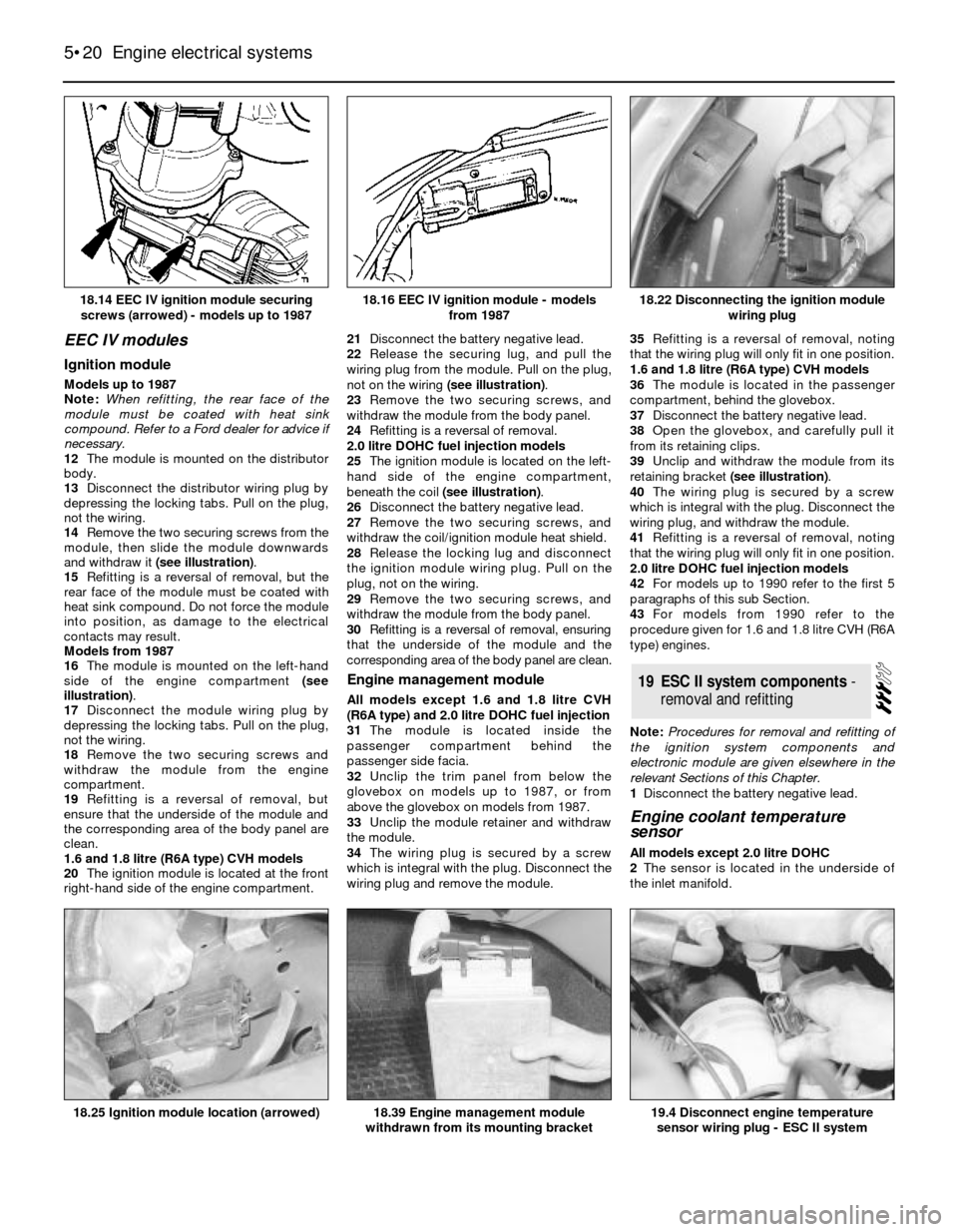
EEC IV modules
Ignition module
Models up to 1987
Note: When refitting, the rear face of the
module must be coated with heat sink
compound. Refer to a Ford dealer for advice if
necessary.
12The module is mounted on the distributor
body.
13Disconnect the distributor wiring plug by
depressing the locking tabs. Pull on the plug,
not the wiring.
14Remove the two securing screws from the
module, then slide the module downwards
and withdraw it (see illustration).
15Refitting is a reversal of removal, but the
rear face of the module must be coated with
heat sink compound. Do not force the module
into position, as damage to the electrical
contacts may result.
Models from 1987
16The module is mounted on the left-hand
side of the engine compartment (see
illustration).
17Disconnect the module wiring plug by
depressing the locking tabs. Pull on the plug,
not the wiring.
18Remove the two securing screws and
withdraw the module from the engine
compartment.
19Refitting is a reversal of removal, but
ensure that the underside of the module and
the corresponding area of the body panel are
clean.
1.6 and 1.8 litre (R6A type) CVH models
20The ignition module is located at the front
right-hand side of the engine compartment. 21Disconnect the battery negative lead.
22Release the securing lug, and pull the
wiring plug from the module. Pull on the plug,
not on the wiring (see illustration).
23Remove the two securing screws, and
withdraw the module from the body panel.
24Refitting is a reversal of removal.
2.0 litre DOHC fuel injection models
25The ignition module is located on the left-
hand side of the engine compartment,
beneath the coil (see illustration).
26Disconnect the battery negative lead.
27Remove the two securing screws, and
withdraw the coil/ignition module heat shield.
28Release the locking lug and disconnect
the ignition module wiring plug. Pull on the
plug, not on the wiring.
29Remove the two securing screws, and
withdraw the module from the body panel.
30Refitting is a reversal of removal, ensuring
that the underside of the module and the
corresponding area of the body panel are clean.
Engine management module
All models except 1.6 and 1.8 litre CVH
(R6A type) and 2.0 litre DOHC fuel injection
31The module is located inside the
passenger compartment behind the
passenger side facia.
32Unclip the trim panel from below the
glovebox on models up to 1987, or from
above the glovebox on models from 1987.
33Unclip the module retainer and withdraw
the module.
34The wiring plug is secured by a screw
which is integral with the plug. Disconnect the
wiring plug and remove the module.35Refitting is a reversal of removal, noting
that the wiring plug will only fit in one position.
1.6 and 1.8 litre (R6A type) CVH models
36The module is located in the passenger
compartment, behind the glovebox.
37Disconnect the battery negative lead.
38Open the glovebox, and carefully pull it
from its retaining clips.
39Unclip and withdraw the module from its
retaining bracket (see illustration).
40The wiring plug is secured by a screw
which is integral with the plug. Disconnect the
wiring plug, and withdraw the module.
41Refitting is a reversal of removal, noting
that the wiring plug will only fit in one position.
2.0 litre DOHC fuel injection models
42For models up to 1990 refer to the first 5
paragraphs of this sub Section.
43For models from 1990 refer to the
procedure given for 1.6 and 1.8 litre CVH (R6A
type) engines.
Note: Procedures for removal and refitting of
the ignition system components and
electronic module are given elsewhere in the
relevant Sections of this Chapter.
1Disconnect the battery negative lead.
Engine coolant temperature
sensor
All models except 2.0 litre DOHC
2The sensor is located in the underside of
the inlet manifold.
19ESC II system components -
removal and refitting
5•20Engine electrical systems
18.14 EEC IV ignition module securing
screws (arrowed) - models up to 198718.22 Disconnecting the ignition module
wiring plug
19.4 Disconnect engine temperature
sensor wiring plug - ESC II system18.39 Engine management module
withdrawn from its mounting bracket18.25 Ignition module location (arrowed)
18.16 EEC IV ignition module - models
from 1987
Page 21 of 24
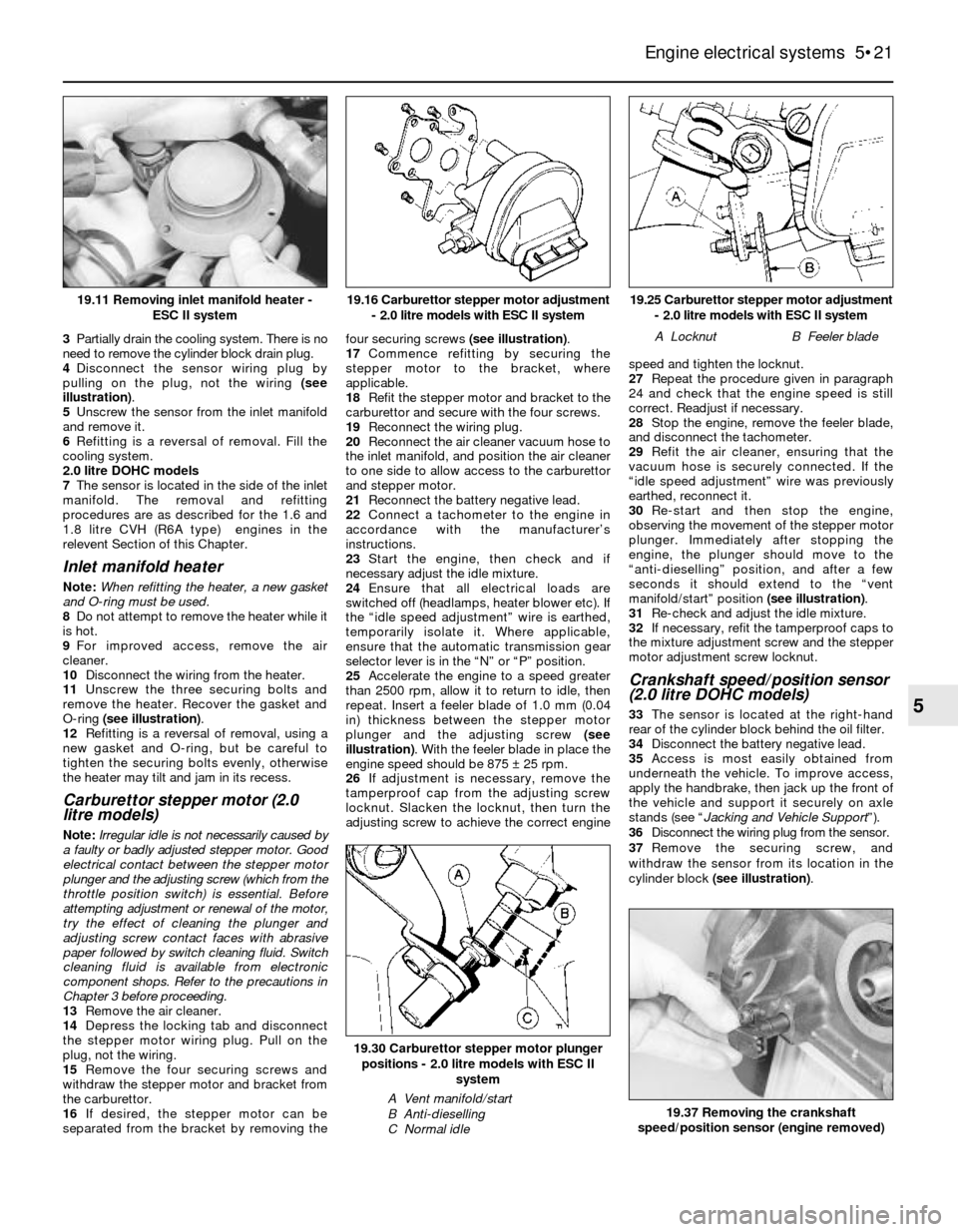
3Partially drain the cooling system. There is no
need to remove the cylinder block drain plug.
4Disconnect the sensor wiring plug by
pulling on the plug, not the wiring (see
illustration).
5Unscrew the sensor from the inlet manifold
and remove it.
6Refitting is a reversal of removal. Fill the
cooling system.
2.0 litre DOHC models
7The sensor is located in the side of the inlet
manifold. The removal and refitting
procedures are as described for the 1.6 and
1.8 litre CVH (R6A type) engines in the
relevent Section of this Chapter.
Inlet manifold heater
Note: When refitting the heater, a new gasket
and O-ring must be used.
8Do not attempt to remove the heater while it
is hot.
9For improved access, remove the air
cleaner.
10Disconnect the wiring from the heater.
11Unscrew the three securing bolts and
remove the heater. Recover the gasket and
O-ring (see illustration).
12Refitting is a reversal of removal, using a
new gasket and O-ring, but be careful to
tighten the securing bolts evenly, otherwise
the heater may tilt and jam in its recess.
Carburettor stepper motor (2.0
litre models)
Note: Irregular idle is not necessarily caused by
a faulty or badly adjusted stepper motor. Good
electrical contact between the stepper motor
plunger and the adjusting screw (which from the
throttle position switch) is essential. Before
attempting adjustment or renewal of the motor,
try the effect of cleaning the plunger and
adjusting screw contact faces with abrasive
paper followed by switch cleaning fluid. Switch
cleaning fluid is available from electronic
component shops. Refer to the precautions in
Chapter 3 before proceeding.
13Remove the air cleaner.
14Depress the locking tab and disconnect
the stepper motor wiring plug. Pull on the
plug, not the wiring.
15Remove the four securing screws and
withdraw the stepper motor and bracket from
the carburettor.
16If desired, the stepper motor can be
separated from the bracket by removing thefour securing screws (see illustration).
17Commence refitting by securing the
stepper motor to the bracket, where
applicable.
18Refit the stepper motor and bracket to the
carburettor and secure with the four screws.
19Reconnect the wiring plug.
20Reconnect the air cleaner vacuum hose to
the inlet manifold, and position the air cleaner
to one side to allow access to the carburettor
and stepper motor.
21Reconnect the battery negative lead.
22Connect a tachometer to the engine in
accordance with the manufacturer’s
instructions.
23Start the engine, then check and if
necessary adjust the idle mixture.
24Ensure that all electrical loads are
switched off (headlamps, heater blower etc). If
the “idle speed adjustment” wire is earthed,
temporarily isolate it. Where applicable,
ensure that the automatic transmission gear
selector lever is in the “N” or “P” position.
25Accelerate the engine to a speed greater
than 2500 rpm, allow it to return to idle, then
repeat. Insert a feeler blade of 1.0 mm (0.04
in) thickness between the stepper motor
plunger and the adjusting screw (see
illustration). With the feeler blade in place the
engine speed should be 875 ±25 rpm.
26If adjustment is necessary, remove the
tamperproof cap from the adjusting screw
locknut. Slacken the locknut, then turn the
adjusting screw to achieve the correct enginespeed and tighten the locknut.
27Repeat the procedure given in paragraph
24 and check that the engine speed is still
correct. Readjust if necessary.
28Stop the engine, remove the feeler blade,
and disconnect the tachometer.
29Refit the air cleaner, ensuring that the
vacuum hose is securely connected. If the
“idle speed adjustment” wire was previously
earthed, reconnect it.
30Re-start and then stop the engine,
observing the movement of the stepper motor
plunger. Immediately after stopping the
engine, the plunger should move to the
“anti-dieselling” position, and after a few
seconds it should extend to the “vent
manifold/start” position (see illustration).
31Re-check and adjust the idle mixture.
32If necessary, refit the tamperproof caps to
the mixture adjustment screw and the stepper
motor adjustment screw locknut.
Crankshaft speed/position sensor
(2.0 litre DOHC models)
33The sensor is located at the right-hand
rear of the cylinder block behind the oil filter.
34Disconnect the battery negative lead.
35Access is most easily obtained from
underneath the vehicle. To improve access,
apply the handbrake, then jack up the front of
the vehicle and support it securely on axle
stands (see “Jacking and Vehicle Support”).
36Disconnect the wiring plug from the sensor.
37Remove the securing screw, and
withdraw the sensor from its location in the
cylinder block (see illustration).
Engine electrical systems 5•21
5
19.25 Carburettor stepper motor adjustment
- 2.0 litre models with ESC II system
A LocknutB Feeler blade
19.37 Removing the crankshaft
speed/position sensor (engine removed)
19.30 Carburettor stepper motor plunger
positions - 2.0 litre models with ESC II
system
A Vent manifold/start
B Anti-dieselling
C Normal idle
19.16 Carburettor stepper motor adjustment
- 2.0 litre models with ESC II system19.11 Removing inlet manifold heater -
ESC II system
Page 22 of 24
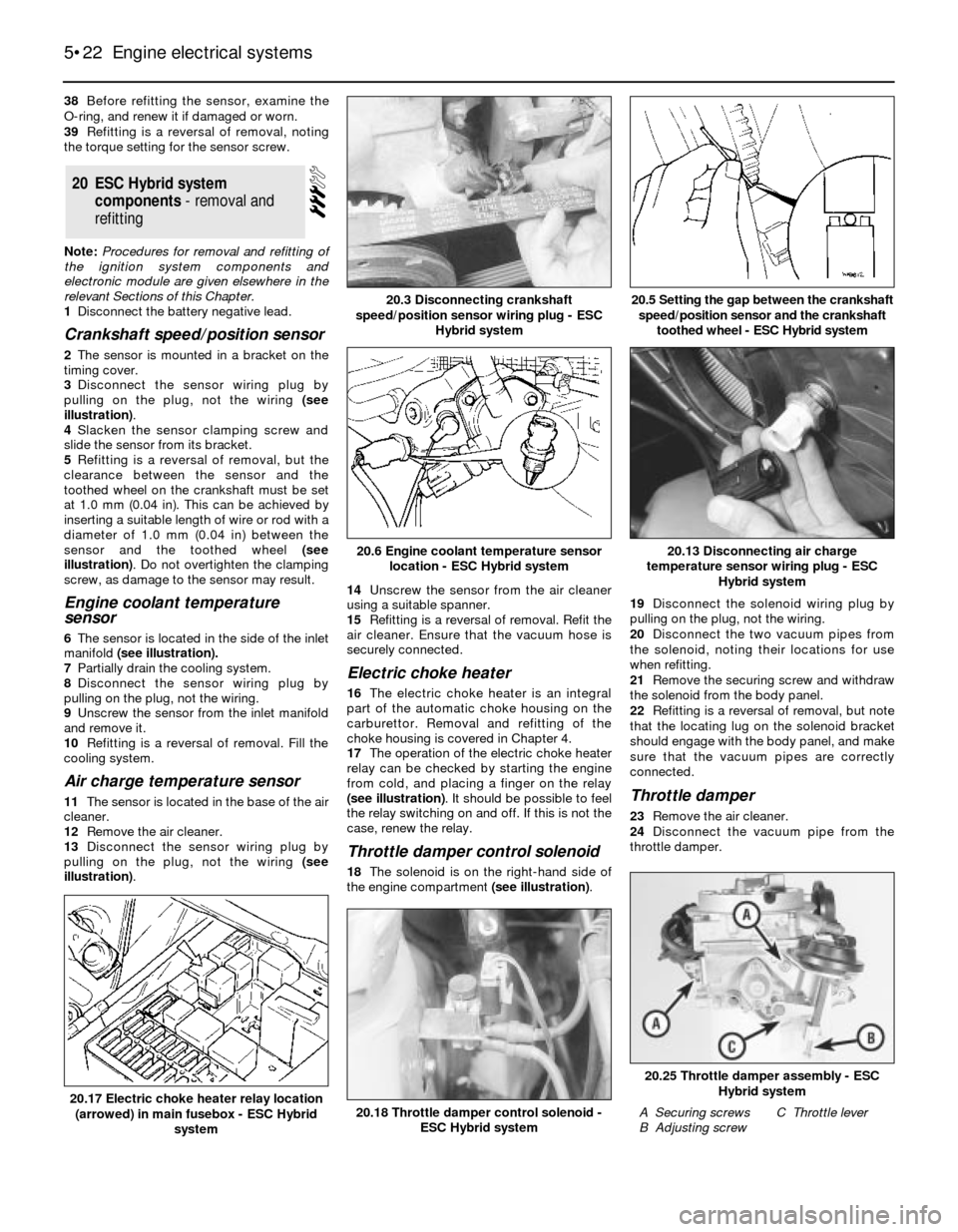
38Before refitting the sensor, examine the
O-ring, and renew it if damaged or worn.
39Refitting is a reversal of removal, noting
the torque setting for the sensor screw.
Note: Procedures for removal and refitting of
the ignition system components and
electronic module are given elsewhere in the
relevant Sections of this Chapter.
1Disconnect the battery negative lead.
Crankshaft speed/position sensor
2The sensor is mounted in a bracket on the
timing cover.
3Disconnect the sensor wiring plug by
pulling on the plug, not the wiring (see
illustration).
4Slacken the sensor clamping screw and
slide the sensor from its bracket.
5Refitting is a reversal of removal, but the
clearance between the sensor and the
toothed wheel on the crankshaft must be set
at 1.0 mm (0.04 in). This can be achieved by
inserting a suitable length of wire or rod with a
diameter of 1.0 mm (0.04 in) between the
sensor and the toothed wheel (see
illustration). Do not overtighten the clamping
screw, as damage to the sensor may result.
Engine coolant temperature
sensor
6The sensor is located in the side of the inlet
manifold(see illustration).
7Partially drain the cooling system.
8Disconnect the sensor wiring plug by
pulling on the plug, not the wiring.
9Unscrew the sensor from the inlet manifold
and remove it.
10Refitting is a reversal of removal. Fill the
cooling system.
Air charge temperature sensor
11The sensor is located in the base of the air
cleaner.
12Remove the air cleaner.
13Disconnect the sensor wiring plug by
pulling on the plug, not the wiring (see
illustration).14Unscrew the sensor from the air cleaner
using a suitable spanner.
15Refitting is a reversal of removal. Refit the
air cleaner. Ensure that the vacuum hose is
securely connected.
Electric choke heater
16The electric choke heater is an integral
part of the automatic choke housing on the
carburettor. Removal and refitting of the
choke housing is covered in Chapter 4.
17The operation of the electric choke heater
relay can be checked by starting the engine
from cold, and placing a finger on the relay
(see illustration). It should be possible to feel
the relay switching on and off. If this is not the
case, renew the relay.
Throttle damper control solenoid
18The solenoid is on the right-hand side of
the engine compartment (see illustration). 19Disconnect the solenoid wiring plug by
pulling on the plug, not the wiring.
20Disconnect the two vacuum pipes from
the solenoid, noting their locations for use
when refitting.
21Remove the securing screw and withdraw
the solenoid from the body panel.
22Refitting is a reversal of removal, but note
that the locating lug on the solenoid bracket
should engage with the body panel, and make
sure that the vacuum pipes are correctly
connected.
Throttle damper
23Remove the air cleaner.
24Disconnect the vacuum pipe from the
throttle damper.
20ESC Hybrid system
components - removal and
refitting
5•22Engine electrical systems
20.3 Disconnecting crankshaft
speed/position sensor wiring plug - ESC
Hybrid system
20.6 Engine coolant temperature sensor
location - ESC Hybrid system
20.25 Throttle damper assembly - ESC
Hybrid system
A Securing screws
B Adjusting screwC Throttle lever20.18 Throttle damper control solenoid -
ESC Hybrid system20.17 Electric choke heater relay location
(arrowed) in main fusebox - ESC Hybrid
system
20.13 Disconnecting air charge
temperature sensor wiring plug - ESC
Hybrid system
20.5 Setting the gap between the crankshaft
speed/position sensor and the crankshaft
toothed wheel - ESC Hybrid system
Page 23 of 24
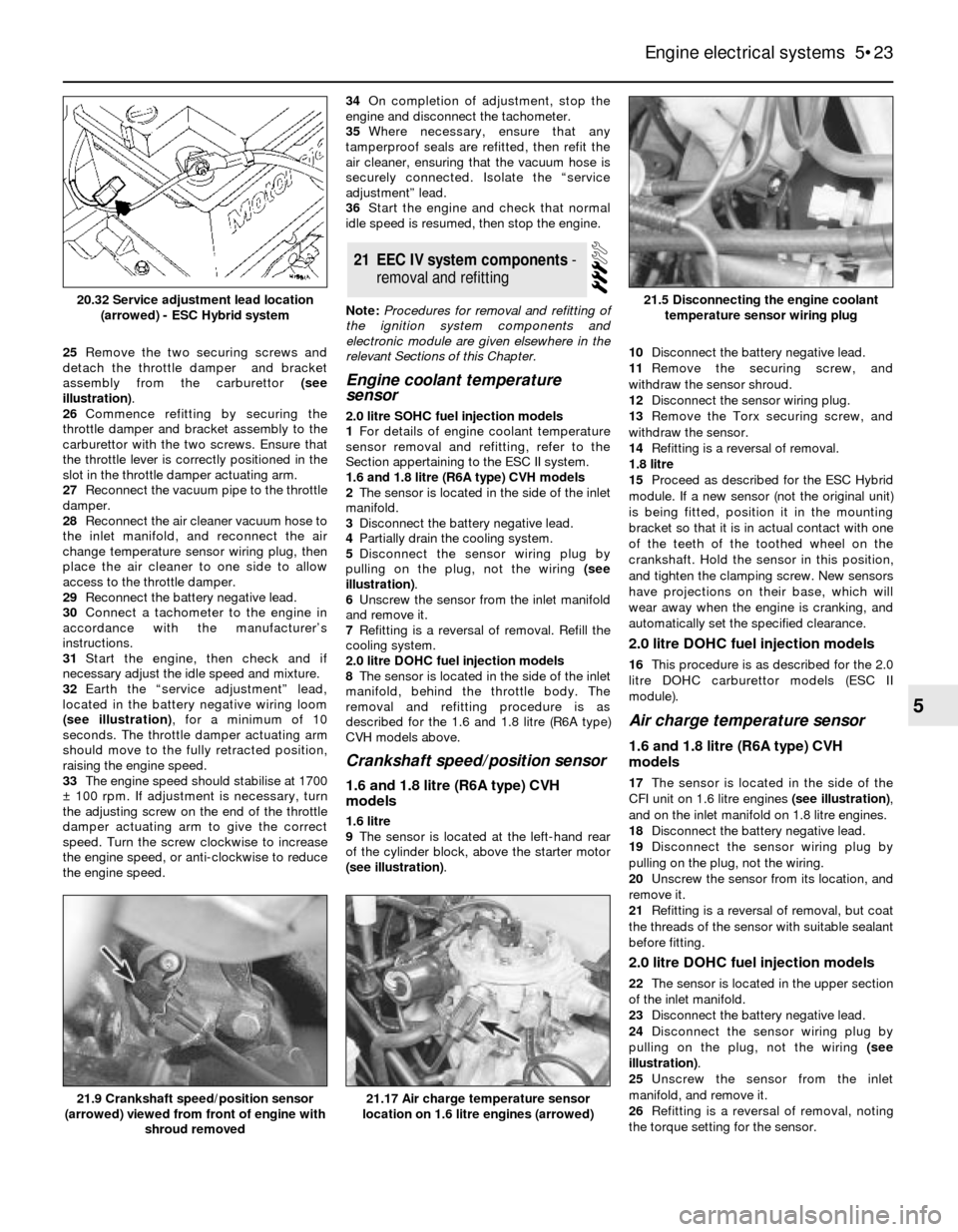
25Remove the two securing screws and
detach the throttle damper and bracket
assembly from the carburettor (see
illustration).
26Commence refitting by securing the
throttle damper and bracket assembly to the
carburettor with the two screws. Ensure that
the throttle lever is correctly positioned in the
slot in the throttle damper actuating arm.
27Reconnect the vacuum pipe to the throttle
damper.
28Reconnect the air cleaner vacuum hose to
the inlet manifold, and reconnect the air
change temperature sensor wiring plug, then
place the air cleaner to one side to allow
access to the throttle damper.
29Reconnect the battery negative lead.
30Connect a tachometer to the engine in
accordance with the manufacturer’s
instructions.
31Start the engine, then check and if
necessary adjust the idle speed and mixture.
32Earth the “service adjustment” lead,
located in the battery negative wiring loom
(see illustration), for a minimum of 10
seconds. The throttle damper actuating arm
should move to the fully retracted position,
raising the engine speed.
33The engine speed should stabilise at 1700
±100 rpm. If adjustment is necessary, turn
the adjusting screw on the end of the throttle
damper actuating arm to give the correct
speed. Turn the screw clockwise to increase
the engine speed, or anti-clockwise to reduce
the engine speed.34On completion of adjustment, stop the
engine and disconnect the tachometer.
35Where necessary, ensure that any
tamperproof seals are refitted, then refit the
air cleaner, ensuring that the vacuum hose is
securely connected. Isolate the “service
adjustment” lead.
36Start the engine and check that normal
idle speed is resumed, then stop the engine.
Note:Procedures for removal and refitting of
the ignition system components and
electronic module are given elsewhere in the
relevant Sections of this Chapter.
Engine coolant temperature
sensor
2.0 litre SOHC fuel injection models
1For details of engine coolant temperature
sensor removal and refitting, refer to the
Section appertaining to the ESC II system.
1.6 and 1.8 litre (R6A type) CVH models
2The sensor is located in the side of the inlet
manifold.
3Disconnect the battery negative lead.
4Partially drain the cooling system.
5Disconnect the sensor wiring plug by
pulling on the plug, not the wiring (see
illustration).
6Unscrew the sensor from the inlet manifold
and remove it.
7Refitting is a reversal of removal. Refill the
cooling system.
2.0 litre DOHC fuel injection models
8The sensor is located in the side of the inlet
manifold, behind the throttle body. The
removal and refitting procedure is as
described for the 1.6 and 1.8 litre (R6A type)
CVH models above.
Crankshaft speed/position sensor
1.6 and 1.8 litre (R6A type) CVH
models
1.6 litre
9The sensor is located at the left-hand rear
of the cylinder block, above the starter motor
(see illustration).10Disconnect the battery negative lead.
11Remove the securing screw, and
withdraw the sensor shroud.
12Disconnect the sensor wiring plug.
13Remove the Torx securing screw, and
withdraw the sensor.
14Refitting is a reversal of removal.
1.8 litre
15Proceed as described for the ESC Hybrid
module. If a new sensor (not the original unit)
is being fitted, position it in the mounting
bracket so that it is in actual contact with one
of the teeth of the toothed wheel on the
crankshaft. Hold the sensor in this position,
and tighten the clamping screw. New sensors
have projections on their base, which will
wear away when the engine is cranking, and
automatically set the specified clearance.
2.0 litre DOHC fuel injection models
16This procedure is as described for the 2.0
litre DOHC carburettor models (ESC II
module).
Air charge temperature sensor
1.6 and 1.8 litre (R6A type) CVH
models
17The sensor is located in the side of the
CFI unit on 1.6 litre engines (see illustration),
and on the inlet manifold on 1.8 litre engines.
18Disconnect the battery negative lead.
19Disconnect the sensor wiring plug by
pulling on the plug, not the wiring.
20Unscrew the sensor from its location, and
remove it.
21Refitting is a reversal of removal, but coat
the threads of the sensor with suitable sealant
before fitting.
2.0 litre DOHC fuel injection models
22The sensor is located in the upper section
of the inlet manifold.
23Disconnect the battery negative lead.
24Disconnect the sensor wiring plug by
pulling on the plug, not the wiring (see
illustration).
25Unscrew the sensor from the inlet
manifold, and remove it.
26Refitting is a reversal of removal, noting
the torque setting for the sensor.
21EEC IV system components -
removaland refitting
Engine electrical systems 5•23
5
21.9 Crankshaft speed/position sensor
(arrowed) viewed from front of engine with
shroud removed21.17 Air charge temperature sensor
location on 1.6 litre engines (arrowed)
21.5 Disconnecting the engine coolant
temperature sensor wiring plug20.32 Service adjustment lead location
(arrowed) - ESC Hybrid system
Page 24 of 24
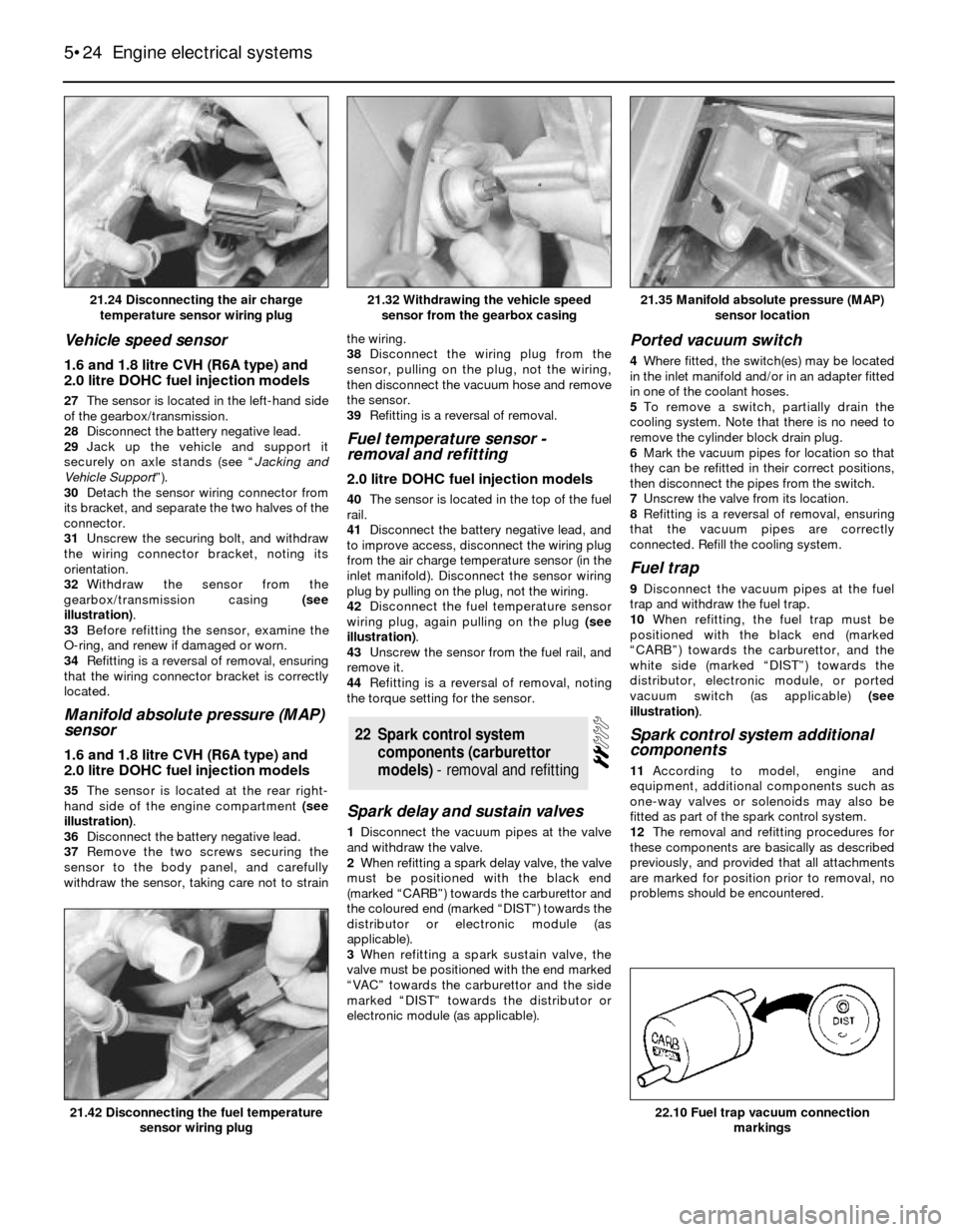
Vehicle speed sensor
1.6 and 1.8 litre CVH (R6A type) and
2.0 litre DOHC fuel injection models
27The sensor is located in the left-hand side
of the gearbox/transmission.
28Disconnect the battery negative lead.
29Jack up the vehicle and support it
securely on axle stands (see “Jacking and
Vehicle Support”).
30Detach the sensor wiring connector from
its bracket, and separate the two halves of the
connector.
31Unscrew the securing bolt, and withdraw
the wiring connector bracket, noting its
orientation.
32Withdraw the sensor from the
gearbox/transmission casing (see
illustration).
33Before refitting the sensor, examine the
O-ring, and renew if damaged or worn.
34Refitting is a reversal of removal, ensuring
that the wiring connector bracket is correctly
located.
Manifold absolute pressure (MAP)
sensor
1.6 and 1.8 litre CVH (R6A type) and
2.0 litre DOHC fuel injection models
35The sensor is located at the rear right-
hand side of the engine compartment (see
illustration).
36Disconnect the battery negative lead.
37Remove the two screws securing the
sensor to the body panel, and carefully
withdraw the sensor, taking care not to strainthe wiring.
38Disconnect the wiring plug from the
sensor, pulling on the plug, not the wiring,
then disconnect the vacuum hose and remove
the sensor.
39Refitting is a reversal of removal.
Fuel temperature sensor -
removal and refitting
2.0 litre DOHC fuel injection models
40The sensor is located in the top of the fuel
rail.
41Disconnect the battery negative lead, and
to improve access, disconnect the wiring plug
from the air charge temperature sensor (in the
inlet manifold). Disconnect the sensor wiring
plug by pulling on the plug, not the wiring.
42Disconnect the fuel temperature sensor
wiring plug, again pulling on the plug (see
illustration).
43Unscrew the sensor from the fuel rail, and
remove it.
44Refitting is a reversal of removal, noting
the torque setting for the sensor.
Spark delay and sustain valves
1Disconnect the vacuum pipes at the valve
and withdraw the valve.
2When refitting a spark delay valve, the valve
must be positioned with the black end
(marked “CARB”) towards the carburettor and
the coloured end (marked “DIST”) towards the
distributor or electronic module (as
applicable).
3When refitting a spark sustain valve, the
valve must be positioned with the end marked
“VAC” towards the carburettor and the side
marked “DIST” towards the distributor or
electronic module (as applicable).
Ported vacuum switch
4Where fitted, the switch(es) may be located
in the inlet manifold and/or in an adapter fitted
in one of the coolant hoses.
5To remove a switch, partially drain the
cooling system. Note that there is no need to
remove the cylinder block drain plug.
6Mark the vacuum pipes for location so that
they can be refitted in their correct positions,
then disconnect the pipes from the switch.
7Unscrew the valve from its location.
8Refitting is a reversal of removal, ensuring
that the vacuum pipes are correctly
connected. Refill the cooling system.
Fuel trap
9Disconnect the vacuum pipes at the fuel
trap and withdraw the fuel trap.
10When refitting, the fuel trap must be
positioned with the black end (marked
“CARB”) towards the carburettor, and the
white side (marked “DIST”) towards the
distributor, electronic module, or ported
vacuum switch (as applicable) (see
illustration).
Spark control system additional
components
11According to model, engine and
equipment, additional components such as
one-way valves or solenoids may also be
fitted as part of the spark control system.
12The removal and refitting procedures for
these components are basically as described
previously, and provided that all attachments
are marked for position prior to removal, no
problems should be encountered.
22Spark control system
components (carburettor
models) - removal and refitting
5•24Engine electrical systems
21.24 Disconnecting the air charge
temperature sensor wiring plug21.35 Manifold absolute pressure (MAP)
sensor location
22.10 Fuel trap vacuum connection
markings21.42 Disconnecting the fuel temperature
sensor wiring plug
21.32 Withdrawing the vehicle speed
sensor from the gearbox casing